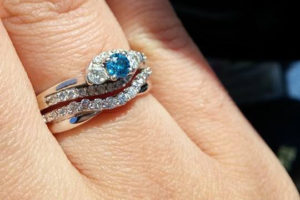Many of us have heard of the 4 Cs of diamond engagement rings: Color, cut, clarity, and carat. But this isn’t a blog post about my engagement ring. Well, it isn’t NOT a blog post about my engagement ring, but it’s mostly a marketing blog. I’m Sonja, I do Market Research for Capacity Marketing, and I want to discuss engagement marketing through the familiar lens of engagement rings.
You see, I have been married for 6 years, and I was engaged for about a year before my husband and I tied the knot. So for 7 years, I have worn the same ring, every day. In the last year, I have had to return my ring to the jeweler 4 times, and I need to take it back for a 5th. The tiny stones around the center trio have started to go missing. The jewelers replace the diamond, re-cap and tighten the settings, and send it back to me. But, for all their repeated efforts, I can only get a month or two of daily wear before I am heading back to the store with my precious ring.
Now, you may be asking yourself what the connection to marketing here is. I admit, my thought process is a little abstract, but every time I make the drive to the jeweler, I keep coming back to the idea of social media. So many companies want tons of followers on their social networks, blogs, and media sharing sites, but nearly every single business would do better on these platforms if they focused on deeper connections with higher quality followers. This is the difference, in my mind, between many tiny diamonds with weak connections that need to be constantly chased around and one to a few larger diamonds with strong connections that require only routine maintenance.
Let me first say that every person has a preference about engagement rings, and I am not here to suggest that any one type is better. I love my ring, even though all the tiny diamonds keep falling out. I love the style. Some folks love a solitaire diamond. Some prefer alternate stones or no engagement ring at all. There’s no right or wrong when it comes to jewelry. But I propose that when it comes to engagement marketing strategy, there is a right and a wrong.
So, expanding on this metaphor and in the interest of helping you to do the right thing to build strong, lasting connections with your customers, let’s talk about the 4 Cs of Engagement Marketing: Customer, Channel, Conversation, and Conversion.
The Four C’s of Engagement Marketing
Customer
When you developed your product or service, you had a buyer persona or even multiple personas in mind. This was the core customer that you expected to seek out your product or service, and this is who most businesses cater their marketing efforts to. Something like: “We designed Bandy as a lightweight, metallic-tone silicon wedding band for working moms of young children who want to protect their valuable jewelry while juggling their busy lives.”

Are you offering your target audience messaging that entices them to engage? Are you handling customer concerns, or feedback in a way that makes them feel connected to your brand? Today’s consumer market wants to feel connected to your brand – your brand voice can help them understand what your business is about.
Sometimes, though, there are surprise customers. Maybe Bandy got popular among military personnel in the Navy and Coast Guard, who can’t wear traditional wedding rings while line handling. Now these people are part of your customer base. Sometimes, even the use cases for your product or service might not be exactly what you initially imagined. After all, some famous brands started out with alternative uses – like bubble wrap, which started as wallpaper, and Play-doh, whose initial application was wallpaper cleaner. Now we’re both imagining cleaning bubble wrap with Play-doh, aren’t we? Let’s get back on track!
The point is that you should keep an eye on your customers and be sure you know who they actually are. Buyer personas can evolve and change over time – so you need data-driven analysis of the people who are your current and historical customers. Having this information makes all your engagement marketing strategies more effective. You can identify your buyer persona or personas by surveying current customers, or by using analytic data on your web and social platforms.
Channel
Having identified your buyer personas, you need to identify where they are on the Internet. There are countless social media channels that can be leveraged for engagement marketing: Social media networks like Facebook and Instagram are pretty much what most folks immediately think of. But a blog is social media. A discussion forum is social media. Even review networks like Yelp and TripAdvisor are social media. Each generation uses the internet differently, with variations in each generation along gender lines. There’s a great deal of variance in the audience on each social media network, as well.
You don’t want to be investing time and effort in making short fun TikTok videos for your brand if your customers are looking for in-depth information about your products and services via long-form content on YouTube, blogs, or LinkedIn. It is the engagement marketing equivalent of sending a mailer for engagement rings to a middle schooler. Yikes!
Learning how your buyer personas search for information on the Internet can also help to reach your target audiences by using effective keyword strategies for your pay-per-click and other digital marketing campaigns.
Conversation
It is generally accepted that a business-to-business (B2B) company should “use the lingo” to establish itself as a trusted and knowledgeable industry resource as well as a provider of goods or services. Return on investment and value proposition are among the most important consideration for business customers – is this a smart business decision? By contrast, a business-to-consumer (B2C) company should try to evoke an emotional response that compels the end-user to connect with your brand. An end user of a product or service wants to feel good about being your customer. You want to talk like your customers think, and you can get a great handle on thought processes by observing how competitors, customers, and industry publications communicate about your product or service when you’re not in the picture.

Speaking to your audience isn’t just about pushing your product or services. Education, free information, and let’s face it…lifestyle content that gives your target audience a glimpse at your values, brand voice, and what your company is all about are key to driving that great engagement. Content marketing for engagement means making connections with the people you want to buy your products.
One thing to note is that content shouldn’t primarily be geared toward selling. It should be about establishing your brand, educating your customers, and learning more about their needs and priorities by facilitating two-way conversations. A sales promotion here and there is fine, but that is a one-way conversation. “Hot engagement ring deals for the perfect Valentine’s Day proposal!” is a headline that may produce some transactional sales. However, the same company might run an article titled, “Five ways to ensure your proposal is a complete surprise!” Notice, the latter headline isn’t about what products the jeweler offers; it implies that the reader will gain valuable knowledge, whether or not they choose to buy directly from the brand. Here’s the hook: If they’re getting lots of actionable information from a single source, their trust in the brand grows, and they’re ultimately more likely to consider that company when a purchase is made.
The best way to open up a two-way conversation with engagement marketing is to directly ask your customers questions. On social media networks, we often see broad questions like, “How did your spouse propose?” or “What was your favorite anniversary gift?” These questions allow a jeweler to learn more about their customers while opening the door to a conversation that they genuinely want to have. Who doesn’t love gushing about their engagement story, and how valuable are those comments to someone looking for ideas about how to pop the question?
It’s important to note, though, that content creation is an investment in your brand that usually takes time to show a return on investment. Whether it’s long-form blog posts, video content, or social media network posts, creating one or two awesome pieces of content isn’t going to skyrocket your sales overnight. However, “evergreen” content – that which retains its value outside of a single sales cycle or season, can have a snowballing effect over time.
Conversion
Conversion sounds like the magical moment when a prospect becomes a bona fide customer. You’ve put in a lot of work to identify your customer, their channels, and to strike up the right conversations with them. They’re ready to say “YES!” to your product or service, right? Well…. Maybe. Conversions are a little more complicated than that. A sale is a type of conversion, but it’s not the only one you’re after in engagement marketing.
Basically, a conversion is any action that moves a prospect further through the buying process. Let’s go back to the engagement ring for a second. Say you are browsing, trying to figure out the perfect ring for your partner. You might enter a search term “solitaire diamond” into a search engine. The jeweler website you click on has a pop-up window that asks for your email in exchange for a 15% off coupon. If you enter your email, that jeweler has just won a single conversion. If you fill out a contact form, if you schedule a consultation appointment with a sales representative, or even if you use the embedded link to call the store – all of these are different types of conversions.

Ok – I know you were dying to see the ring that spurred on this conversation about engagement marketing…even if you weren’t, here it is!
So how do you increase conversions? Calls to action (CTA) are integral to conversions. But not all CTAs are created equally. Some calls to action are just too vague: “Buy now!” “Add to cart!” “Take a tour!” Everyone is offering these opportunities, and your CTA sounds like an echo. When differentiating your CTAs, consider that prospective customers know on some level that they are performing a conversion and are giving you information in exchange for something they want. But the words you use don’t have to explicitly state that this is transactional.
Words like “submit,” “invest,” and “buy” effectively demand that there is some active performance required by the prospect. These are referred to as high friction words, and they make the conversion sound like a chore. The middle friction range, instead, suggests that there may be some effort, but in the end the prospect is benefiting from the transaction: “join,” “visit,” and “share.” The best CTA words are low friction. Words like “reveal,” “get,” and “earn” make it clear that the winner in this conversion transaction is the prospect.
Want to chat more about engagement marketing, or any of the other fluid and networked services our team can help you with? Head on over to our contact form to discover more. Our team of highly dedicated marketing professionals is ready to help you with your big ideas. Capacity Marketing is here to help build strong relationships with prospects and turn them into lifelong customers.